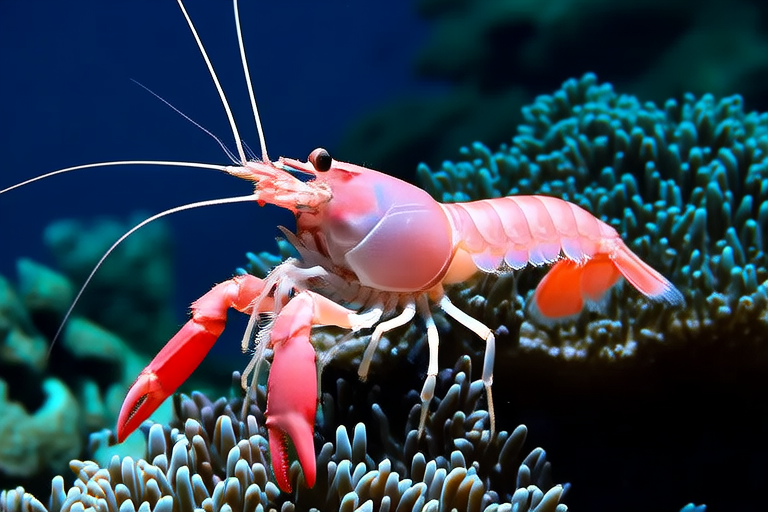5 Reasons Coral Shrimp Are a Must-Have for Your Saltwater Tank
Coral shrimp, also known as Pontonides randalli, are small, vibrant creatures that add a splash of color and life to any saltwater aquarium. These tiny crustaceans, native to the tropical and subtropical waters of the Indo-Pacific region, play a crucial role in maintaining the delicate balance of their natural reef environments. In the wild, they thrive in the crevices and under the corals of shallow reefs, where they serve as efficient cleaners, feeding on detritus and microorganisms. Their presence in home aquariums not only enhances the visual appeal but also contributes significantly to the overall health and well-being of the tank ecosystem.
The Natural Habitat and Role of Coral Shrimp
Native to the warm waters of the Indian and Pacific Oceans, coral shrimp can be found in areas rich with coral formations. They inhabit shallow reefs, where they find shelter among the intricate branches and crevices of hard corals. These environments provide them with ample food sources and protection from larger predators. In their natural habitat, coral shrimp play a vital role in the reef ecosystem by keeping the substrate clean and free from debris. They are also known to assist in the maintenance of coral health by consuming harmful microorganisms that could otherwise damage the delicate polyps.
Reason 1: Water Quality Improvement
One of the primary reasons coral shrimp are highly recommended for saltwater tanks is their ability to improve water quality. These diligent scavengers consume organic waste and leftover food particles, thereby reducing the accumulation of detritus that can lead to poor water conditions. By continuously cleaning the substrate and rocks, coral shrimp help maintain a healthier environment for all tank inhabitants. This constant activity also helps in minimizing the need for frequent water changes, which can be beneficial for both the aquarist and the aquatic life.
Reason 2: Effective Algae Control
Algae growth is a common challenge faced by many saltwater aquarium owners. While some algae are beneficial, excessive growth can overshadow corals and other desirable plants, leading to an imbalance in the tank’s ecosystem. Coral shrimp are adept at controlling algae proliferation. They feed on various types of algae, including diatoms and cyanobacteria, helping to keep these populations in check. By keeping algae levels manageable, coral shrimp contribute to a more balanced and visually appealing tank environment.
Reason 3: Compatibility with Other Species
Coral shrimp are generally peaceful and non-aggressive, making them excellent companions for a wide variety of saltwater tank inhabitants. They coexist well with most fish, invertebrates, and corals, provided there is enough space and hiding spots. Their small size and gentle nature ensure they do not pose a threat to other tank dwellers. Additionally, they are known to be particularly beneficial for clownfish, as they help keep the anemones clean and free from parasites. The symbiotic relationship between coral shrimp and clownfish can create a captivating dynamic within the aquarium.
Reason 4: Aesthetic Appeal
Aside from their functional benefits, coral shrimp bring a significant aesthetic value to saltwater tanks. Their bright red or orange hues, combined with their translucent bodies, create a striking contrast against the vibrant colors of corals and other marine life. Watching these active and curious shrimp scurry around the tank can be a delightful experience for both novice and experienced aquarists. Their movements add a sense of dynamism and life to the aquarium, enhancing its overall beauty and appeal.
Reason 5: Stress Reduction for Tank Inhabitants
In addition to their physical benefits, coral shrimp play a role in reducing stress among tank inhabitants. By keeping the environment clean and free from excess debris, they contribute to a more stable and comfortable living space for all residents. This can lead to improved health and longevity for fish and other marine organisms. Furthermore, their presence can have a calming effect on more sensitive species, helping to reduce aggression and territorial disputes within the tank.
Tips for Maintaining a Healthy Environment for Coral Shrimp
To ensure your coral shrimp thrive in your saltwater tank, it is important to provide them with a suitable habitat. Start by ensuring the water parameters are stable and within the recommended range for saltwater aquariums. Maintain a temperature between 72-82°F (22-28°C), a pH level of 8.1-8.4, and a specific gravity of 1.023-1.025. Regular water testing and partial water changes will help keep the environment pristine.
Provide plenty of hiding spots and caves for the shrimp to retreat into when needed. This can include live rock, ceramic structures, and other decorations that mimic their natural reef environment. It is also advisable to avoid overcrowding the tank, as this can lead to increased competition for resources and potential stress.
Feeding coral shrimp can be relatively simple. They are omnivorous and will naturally feed on detritus and algae in the tank. However, you may want to supplement their diet with occasional offerings of high-quality marine flakes or pellets. Avoid overfeeding, as excess food can lead to poor water quality.
Lastly, consider the compatibility of other tank inhabitants. While coral shrimp are generally peaceful, they may be preyed upon by larger, predatory fish. Choose tank mates carefully to ensure a harmonious environment for all species.
Conclusion
Coral shrimp are more than just colorful additions to your saltwater tank; they are valuable contributors to the overall health and aesthetics of the ecosystem. Their ability to improve water quality, control algae, enhance compatibility, and reduce stress makes them indispensable for any serious aquarist. By following the tips outlined above, you can ensure that your coral shrimp thrive and continue to benefit your tank for years to come. Embrace the joy of observing these fascinating creatures and enjoy the vibrant, thriving environment they help create.
